-
WELCOME
General Information
Home Best Caribbean Island Anguilla Vacations Air Travel to Anguilla Car Rentals Weather -
SLEEP
-
REALTY & BUSINESS
-
THINGS TO DO
-
EAT
- SPECIAL
- KEEP IN TOUCH
- SAVE 10%
|
|
By: Kristin Bourne
Captain Errol "Karu" Romney of De Tree
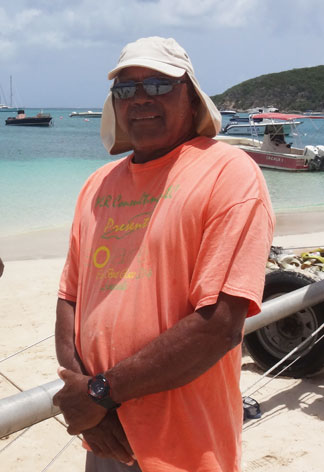
Hard work, dedication, passion and love.
... it's what Anguilla's national sport, boat racing is made of.
Rich in history and steeped in aspects specific to Anguilla racing boats, I joined the crew of De Tree to better understand what goes into boat racing before setting sail on racing days.
Boat builder Ian Carty of Sandy Ground...
Former Sonic racer Claudel "Punky" Richardson of Sandy Ground...
And, a Captain with many winning races under his hat, De Tree's Errol "Karu" Romney of Blowing Point...
Collectively, these men gave me a first hand look at what it's like to prepare an Anguilla racing boat for a big day at sea.
A national sport born out of unique cultural circumstances, you can read about how boat racing came to be in Anguilla here.
Today, excitement over boat racing builds as the boat racing season approaches. The season begins in mid-to-late March and ends in early-to-mid August. The weather/wind conditions are better-suited for sailing this time of year in Anguilla, with milder weather on-island. The boats tend not to race in winds of 16 knots or higher (which tend to blow through the island in winter/spring months).
During this period, the boats are in and out of the sea, over and over again, depending on the schedule of races. Given the nature of the boats themselves, the set up is an interesting process to see.
All Anguilla racing boats are made from scratch. Wooden sail boats that race without motor, they are structurally sound, but, make no mistake... they do not have any luxuries such as computers (for direction) or even decks.
This goes for the two different class sizes of boats with the largest, the 28 foot Class A boat, being the most readily raced in organized competitions. Class B boats are 23 feet.
Class A boat, Miss Anguilla
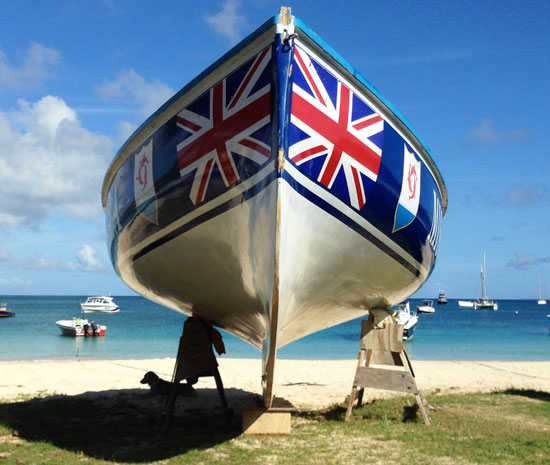
Class B boats De Storm, Hurricane and Tornado
race near Anguilla's Island Harbour
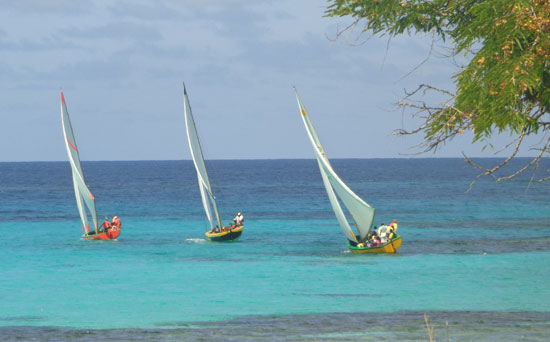
Composed of different moving parts, each time a sail boat goes in the water, it requires quite a bit of set up and, of course, "man power".
Real Deal puts a bow anchor on the beach
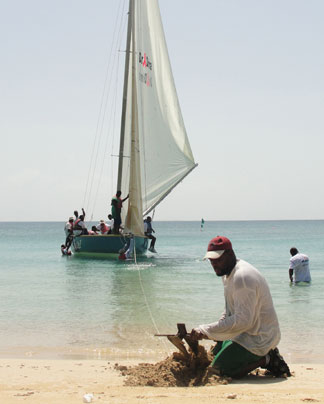
Once they are in the water and waiting gracefully to race, you can see them close to the beach in Sandy Ground.
They gently bob in the calm water as they are anchored out to sea on their stern side with the bow pointing toward the beach, the bow rope tied either to a sand-covered anchor and in some instances, even tied to a coconut palm tree.
When there are 10 or so boats in the water it can make a simple beach walk a little more exciting as you look out for the rise and fall of their ropes as the sea moves the boats, tightening and loosening their restraining ropes.
Not a single Anguilla racing boat owner enjoys leaving their boat in the water for an extended period of time, though. They rest easier when the boats are safely in the village yard or wherever the boat is maintained and stored.
Historically, the boats have been built and manned by different villages in Anguilla and by a crew who are often related.
De Tree rests safely in Ian Carty's yard where she
gets worked on in the "off season".
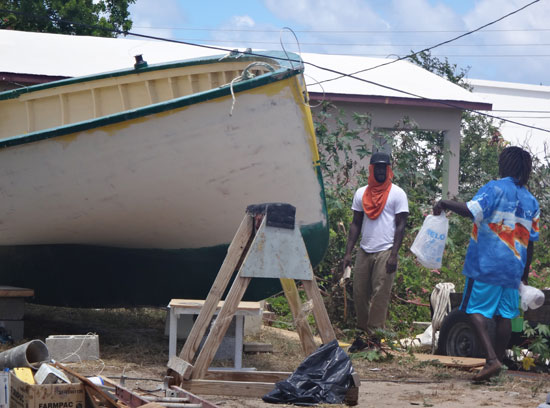
More often than not, a core family puts money and time in to build a boat with the help of sons/daughters, brothers/sisters, cousins, nieces/nephews, grandchildren and great-grandchildren, and thus, the heritage lives on.
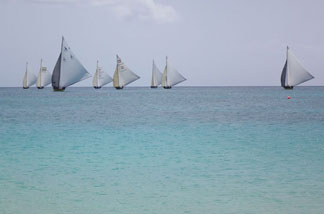
As with other skills and trades that are handed down and sometimes lost over time, it's the general hope that the youth of Anguilla also learn to respect, be involved with and love something that has been important to the island for decades, something that was born out of necessity; once a hardship turned into a positive passion.
A few examples of such passing down of knowledge and skills? Real Deal, the boat and Richardson family stemming from Anguilla's village of North Hill and De Tree, the boat and Romney family from Anguilla's village of Blowing Point.
I've spent time observing the work of Ian Carty, who is an engineer for traditional racing boats, and he has stored and worked on De Tree since 2000 when he first reshaped "her".
It's family. It's dedication and investment. It's many hours of work. He knows her and takes care of her like one cares for a child. He doesn't race on her but he's there with her, getting her in the water, tweaking her, breaking her down (if needed), shaping, painting, assessing, advising and so on.
The interior of De Tree
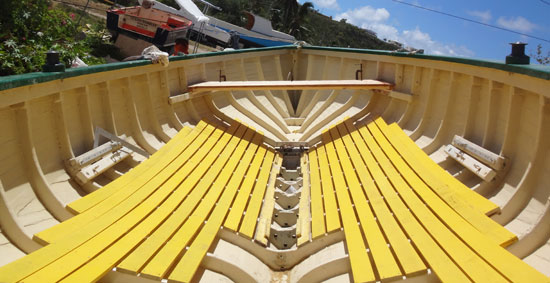
The day I watched the set-up of De Tree, the morning of a race in June, Ian introduced me to the long-running and successful man at the tiller, Captain Errol Romney.
It was clear that Errol and Ian had done this together a multitude of times.
While the full racing crew wasn't there for all of the set-up there were a handful of men there to begin what is a lot of physical work. Among them was a man who often helms De Tree, Captain Ross Romney, Errol's nephew.
After the boat goes in the water, which is ideally (and modernly) placed in the sea via a trailer pulled by a truck or tractor, she then needs to be weighted down.
Sonic is ready to enter the water from its trailer
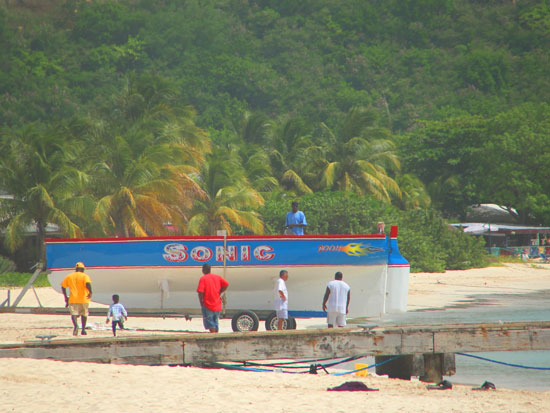
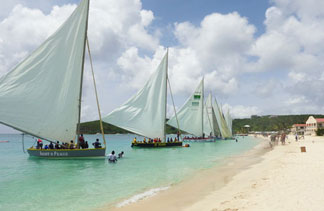
This is where the first round of heavy lifting comes in. Lead ballasts are carried to the boat, piece by piece. The ballasts hold the boat steady and keep it from capsizing.
You can say that the lead is "customized" as its placed in specific spots in each boat, each time.
Where does the lead come from? Errol told me that in some cases the lead comes partly from melted down batteries and sometimes is purchased from St. Martin and melted in Anguilla to supplement the volume needed.
One piece of lead ballast can weigh around 200 pounds. I watched some very strong men carry these heavy pieces of lead from deep sand up in to the boat. They make it look easy but you can clearly see how disproportionately heavy these ballasts are in comparison to the size of the people handling them.
Certain crews will also form a train and hand off the pieces until the boat is filled. Once the boat is filled, she still balances nicely on top of the water but more of the keel is underwater and the hull rests at the waterline.
Next step is getting the mast in place. Again, human strength comes into play. De Tree's crew carries their mast toward the boat and sets it in place (the jib already attached to the mast).
The mast is carried on board...
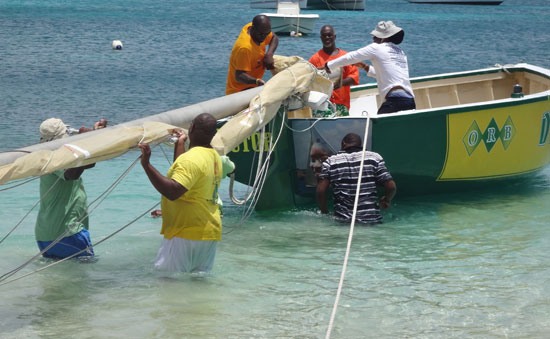
The mast is pulled by ropes in to place...
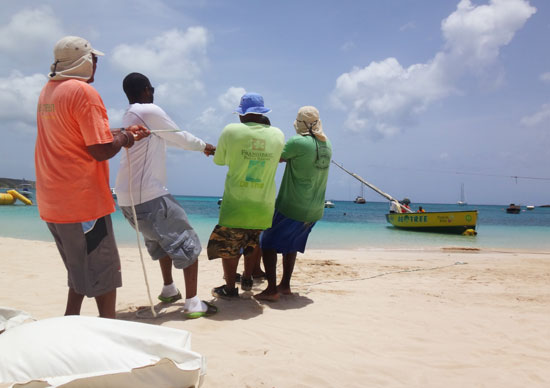
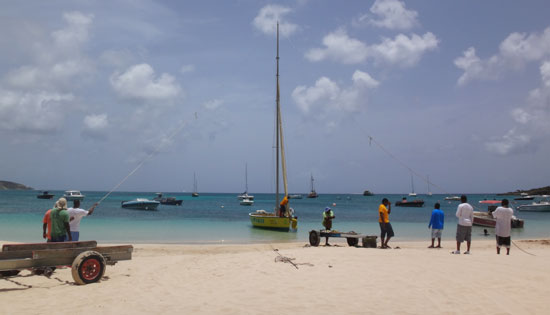
The jib is secured.
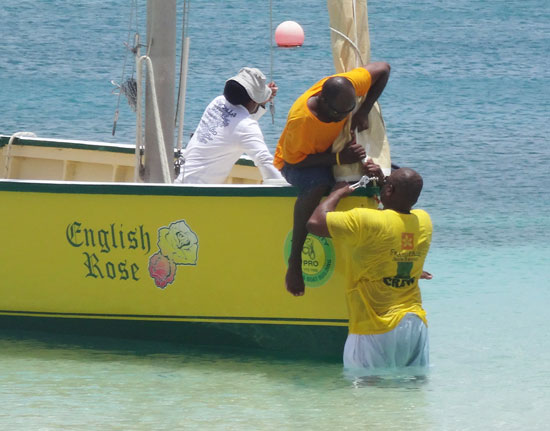
Next, the enormous sail is carried aboard and then attached to the mast before being hoisted.
De Tree crew carry the sail to the boat.
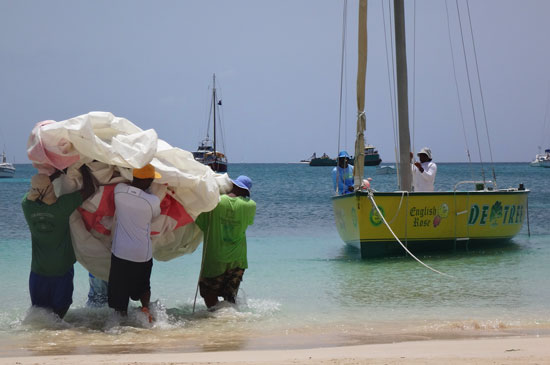
You may notice a small emblem on the sail. That indicates that the size of the sail has been approved by the Anguilla Racing Boat Committee.
I was quietly amused to learn that because I've always heard how very few rules and regulations exist in Anguilla boat racing as International rules are not necessarily applied. That which has been done throughout history in Anguilla, learned and passed down is what applies.
De Tree's ABRC sail size approval
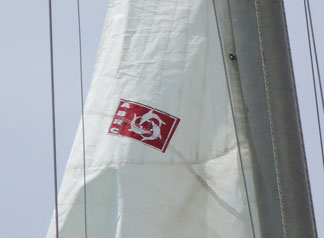
However, to maintain some consistent standards, it makes perfect sense and it's fun to have a look at each sail in order to the find the mark of approval. They are placed either up top or near the middle of the sail.
De Tree's sail approval is near the top. Her sail is an example of a more modern practice in that it displays a sponsor. The sail sponsor is the Meads Bay boutique hotel Frangipani.
Since boat racing is an expensive activity to maintain, sponsorship is a big help and it's gorgeous exposure for the sponsor as well as a fine way to support the heritage sport.
Sponsors also show up in the paint jobs on the hull. In the case of Ian's logo on De Tree, the crew surprised him by adding a special logo thanking him for his commitment, time and work.
The other logos on De Tree are for ORB (Orchard, Romney and Beck) Construction company and The Valley restaurant The English Rose.
After the mast and sail comes the boom. Still heavy but not as cumbersome as the mast.
The boom is brought on board...
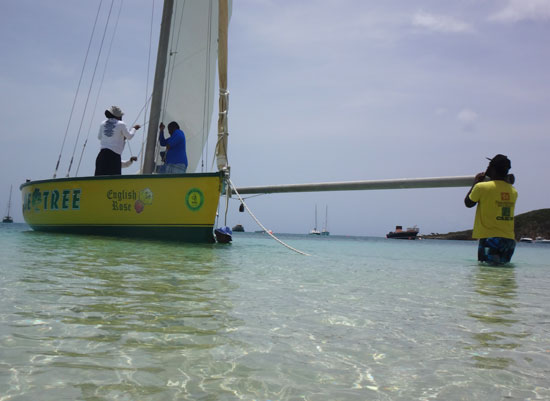
Laced and set.
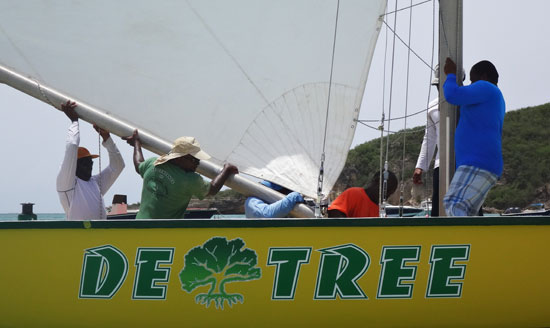
Generally the sandbags go in last.
Before they were loaded onto De Tree on the morning I visited with them, I leaned over to a prepared sandbag on the beach, and with one hand, tugged at it just to see how heavy it really was. I'm stronger than I look, but I can't say that it budged.
De Tree's sandbags, ready to go
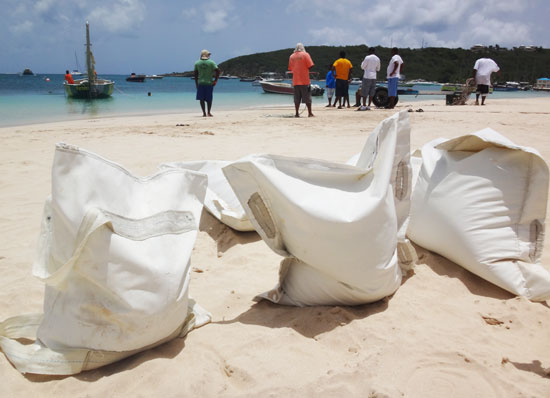
The sandbags are a brilliant part of racing. They offer versatility without harming the ocean by throwing heavy ballasts or people overboard. The bags are simply opened and sand is dumped out as needed.
It's a pretty sight as it's dumped, too... the sand lights up the deeper blue water to a light turquoise.
Other "last checks" on the boat include an interestingly shaped tool that Ian called out for that morning, "the gun". Sure enough a cartoon-sized revolver shaped piece was handed to Ian and he used it on the cables. Captain Errol explained that is was to check the tension of the cables for the mast.
Ian uses the "gun" to check tension on the sail cables
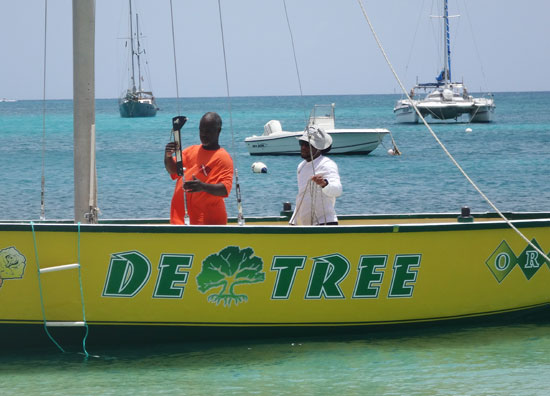
After everything was in order, the remaining crew began showing up. Crew size varies from race to race but generally the captain is looking for about 20 people. Life jackets were put on and the men and one woman boarded De Tree...
De Tree crew climbs aboard and depart Sandy Ground for Meads Bay
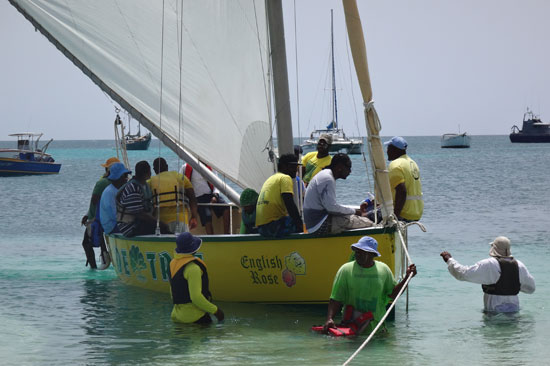
The race was set to start from Meads Bay, sail to Anguillita in the west and finish at Meads Bay.
I left Sandy Ground (where they were preparing the boat) and drove to Meads Bay and by the time I got on the beach, there was De Tree in place and ready to race... finally. Let the excitement begin!
Captain Errol Romney (on the stern) and crew await the start of their Meads Bay race
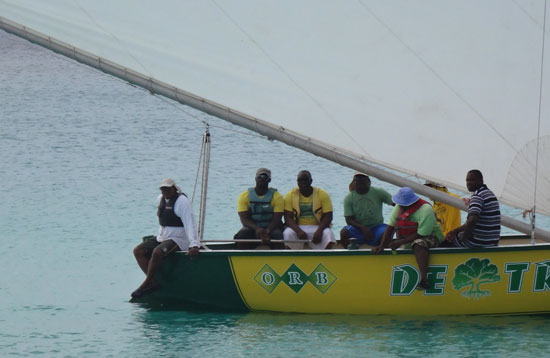
It was a long day at sea and it was starting to get dark as the racing boats made their way back to their overnight resting spot in Sandy Ground after the race.
They would then go through the process of removing the sail as they had another race again the next day.
If they didn't have another race the next day, they would be undoing all the the work they had done that morning or even more. They may even take the boat out of the water that evening.
And that's a day of leisure and pleasure! Yes, it demands plenty of physical work and long hours, but it's all for the love of boat racing.
This important effort being made, and likely by those whose ancestors before them were sailors and boat builders, is vital in keeping this exciting and beautiful cultural activity alive.
Boat racing and family support go together:
Errol's nephew and great nephew on shore for De Tree's return.
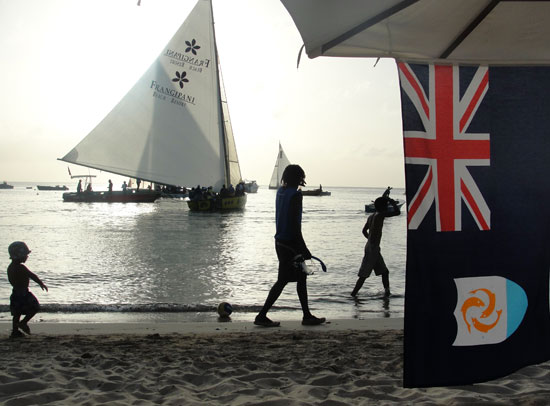
Special thanks to Ian, Claudel and Errol for their time in educating me on the specifics of boat racing. I appreciate their passion and input on the topic and for helping to keep the youth involved in their unique and wonderful national sport of boat racing.

Tranquility Beach
(Luxury Hotel & Residences)

Long Bay Villas:
The Ultra-Luxury Villas
Sky, Sea & Sand

Santosha Villa Estate:
Anguilla's Most Sophisticated
Ultra-Luxury Villa
Facebook Comments
Have your say about what you just read! Leave a comment in the box below.